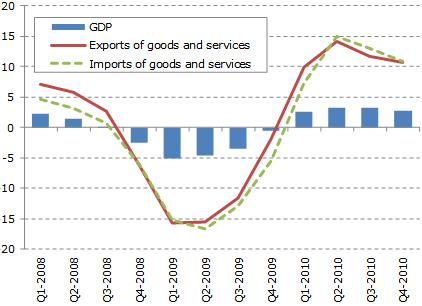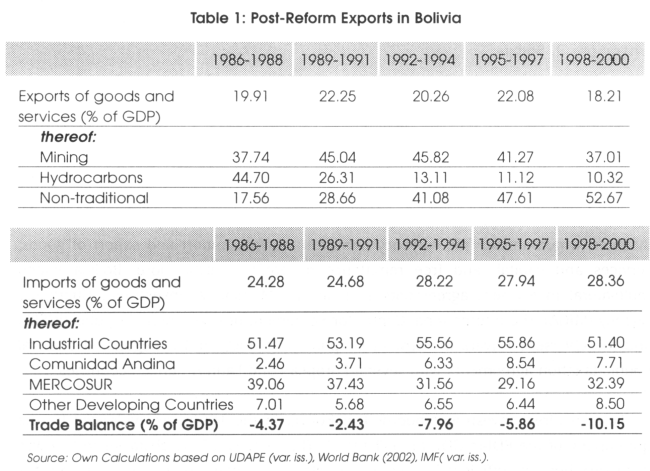International Finance Effect on Imports Exports and GDP
Post on: 2 Октябрь, 2015 No Comment

Effect on Imports, Exports, and GDP
International Finance
Recall the formula for gross domestic product, C + I + G + (Ex — Im). The expression (Ex — Im) equals net exports, which may be either positive or negative. If net exports are positive, the nation’s GDP increases. If they are negative, GDP decreases. All nations want their GDP to be higher rather than lower, so all nations want their net exports to be positive. (Of course it is not possible for all nations to have positive net exports because one or more nations must import more than they export if the others export more than they import.)
Returning to our example of the United States and Mexico, here is the sequence of events I just described and the impact on trade and GDP:
- U.S. demand for Mexican imports increased.
- This increased U.S. demand for pesos.
- The increased U.S. demand for pesos raised the price of the peso in dollars.
- When Americans purchase more imports from Mexicoholding all else equalU.S. net exports (and GDP and employment) will decrease.
- However. the change in the exchange rate will automatically correct this situation, because a) as the price, in dollars, of Mexican imports rises, U.S. demand for Mexican imports will fall, and b) as the price, in pesos, of U.S. exports to Mexico falls, Mexican demand for U.S. products will rise.
- When U.S. exports to Mexico rise (because they are cheaper), it will reverse the trend that began when U.S. demand for Mexican products increased. It will also reverse the effect on U.S. net exports, which will increase when exports to Mexico increase.
The price of the peso in dollarsthe dollar-peso exchange rateis determined by U.S. demand for Mexican goods and Mexican demand for U.S. goods. However, when the exchange rate changes, that affects the price of each country’s goods. That price change affects each country’s demand for the other’s goods in ways that tend to reverse the initial trend.
This mechanism depends on floating exchange rates. If exchange rates are not permitted to respond to the forces of supply and demand, these automatic adjustments cannot occur. Given the high levels of international trade in the world today, and the managed float nature of exchange rates, the economies of most nations are intertwined in various ways. Let’s examine some of those ways.

The Balance of Payments
EconoTip
The U.S. balance of payments includes a current account, which summarizes imports and exports and a capital account, which summarizes forgiveness of debts, transfers of goods or financial assets accompanying migrants, and other transfers of assets. It also includes a financial account, which summarizes U.S. and foreign investment in fixed assets, securities, and other financial assets, and intangible assets. The current account should balance out to zero against the sum of the capital and the financial accounts.
The balance of international payments, commonly known as the balance of payments, is the overall accounting of a nation’s international economic activity. It is a statement summarizing the transactions that took place between a nation and the rest of the world, usually over a calendar quarter or year. It shows the sum of all the transactions between the individuals, businesses, and government agencies of the nation and those of the rest of the world.
Transactions are recorded as debits and credits in the balance of payments. Transactions that cause money to flow into the country (inflows) are credits, and those that cause money to leave the country (outflows) are debits.
For example, if the U.S. exports a cement mixer to Brazil, the transaction is a credit to the U.S. balance of payments and a debit to Brazil’s balance of payments. If Malaysia borrows $1.5 billion from the U.S. government, the transaction is a debit to the U.S. balance of payments and a credit to Malaysia’s. However, when Malaysia makes its first payment on the principal and interest on the loan, it is a credit to the U.S. balance of payments and a debit to Malaysia’s.
The balance of payments statement divides international transactions into three accounts: the current account, capital account, and financial account, as follows:
- The current account includes trade in goods and services; income receipts, such as dividends and interest; and unilateral transfers of assets, such as foreign aid.
- The capital account includes forgiveness of international debt, migrant transfers (goods or financial assets accompanying migrants into or out of the country), transfers of funds arising from gift and inheritance taxes, and uninsured damage to fixed assets.
- The financial account records trade in fixed assets such as companies and real estate; in financial assets such as stocks and bonds; in government-owned assets and foreign-owned assets in the United States; and in rights and intangible assets, such as mineral rights, copyrights, patents, trademarks, franchises, and leases.
EconoTip
Although economists used to point out that services generally were not exportedhaircuts were the favorite examplethat has changed. The vast majority of international trade is still in goods, but trade in services has grown considerably over the past two decades. Categories of services exported and imported include transportation, financial, consulting, engineering, and telecommunications services.
Each of these three accountsthe current account, the capital account, and the financial accountis summed separately. The sum of the current account should balance with the sum of the capital account plus the financial account. Thus, the current account should balance out to zero against the capital and financial accounts. In practice, the balance is close to zero relative to the sums involved, but is rarely exactly zero. This is due to statistical discrepancies, accounting conventions, and exchange rate movements that change the recorded value of transactions.
Why should the current account balance out to zero against the capital and financial accounts?
Because when the United States imports more goods and services than it exports, the result is a current account deficit. The United States must finance that current account deficit, either by international borrowing or by selling more capital assets than it buys internationally. Conversely, when the United States exports more that it imports, its trading partners must finance their current account deficits, either by borrowing or by selling more capital assets than they purchased.
Table 18.2 shows the U.S. balance of payments for 2001.
Table 18.2  U.S. Balance of Payments, December 31, 2001(billions of dollars)














